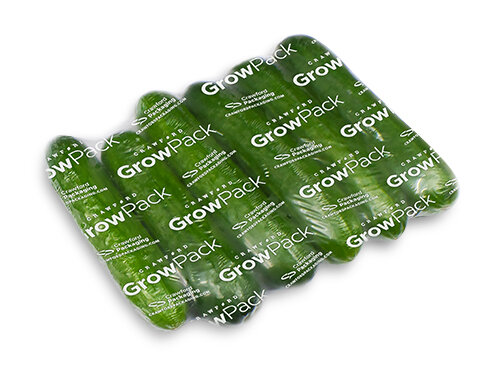Canada Day Delivery Notice
Our office will be closed on Tuesday, July 1st for Canada day. To ensure that our customers’ supplies remain at optimum levels during this period, we’ve created a modified delivery…
Are you a produce grower or packer that currently packs with shrink wrap and trays? Then this post is for you! Recent studies have shown that only 35% of food packaging was properly recycled within the last year[1], making waste reduction very important. What if we told you we can make sustainable shrink wrap packaging even easier and reduce material waste by 50%?

The amount of unnecessary waste put out in the environment each year is a great indicator that consumers may not know how to properly recycle their food packaging.
Trays are made up of various materials, the most popular materials are foam, plastic, and most recently compostable cardboard. Foam trays can be challenging for the end-user to recycle, and while most plastic trays are recyclable – they don’t always end up in the proper waste stream 100% of the time.
So, trays are the bad guy? No, of course not – many applications require trays to successfully package products. But with recent advancements in shrink packaging equipment, not every shrink application requires to use trays. Removing trays from your packaging process can reduce your carbon footprint up to 55% – who wouldn’t want that? Essentially, trays start to become part of the problem when they are used when they don’t need to be.

To this day, shrink film packaging is one of the most efficient packaging formats because it is typically only 1%-2% of total packaging material in the whole industry.
We use a lineup of BVM Brunner shrink wrappers to package fresh produce without the need for trays. The BVM Brunner series is the most versatile and flexible shrink wrapping machine on the market so you can essentially shrink wrap anything you can think of! BVM shrink wrappers automatically detect and move product into proper position to create a bundled pack.
Many shrink and stretch films are made of chlorine-based polyvinyl chloride (PVC). This was the traditional material for shrink wrap packaging but over the years, it has become apparent that PVC shrink films release toxins into the environment and create carcinogenic gases during the manufacturing and recycling process.
Non-toxic, environmentally friendly polyolefin shrink film has the same performance as PVC shrink film. Recent studies have shown that 74% of consumers are willing to pay slightly more for packaging if it is sustainable or fully recyclable packaging.[2]
What does that mean you ask? This means, choosing a shrink film that doesn’t contain toxic materials will continue to be one of the most efficient packaging formats, enhance sustainability, reduce shrink wrap packaging waste, and is 100% recyclable packaging!

One thing that often challenges produce growers/packers is the limited time produce remains fresh from picking to packing and on to retail shelves. Typically, the average shelf life for a traditional shrink wrapped pack is only 5-7 days simply due to the condensation that builds up. What if we told you that anti-fog shrink film can increase your shelf life up to an additional 2 weeks! You probably wouldn’t believe us.
This sustainable film was recently put to the test against a pack of 6 mini cucumbers packed in a traditional shrink film and tray. The anti-fog film helped the cucumbers maintain a firm texture for four weeks due to the controlled transpiration and the moisture retention properties of the film.

Discover the Shrink It Right Program
Shrink It Right audits existing shrink wrap equipment, materials and process. The program identifies areas of inefficiency and works with you to create solutions to optimize your shrink wrap packaging operation.
Trayless anti-fog shrink film packaging is ideal for fresh produce options including:
Mini and regular-sized cucumbers
Tomatoes
Corn on the cob
Potatoes
Our office will be closed on Tuesday, July 1st for Canada day. To ensure that our customers’ supplies remain at optimum levels during this period, we’ve created a modified delivery…
Packaging plays a vital role in today’s fast-paced business landscape, ensuring product protection, preservation, and presentation. As the packaging industry continues to grow and adapt to changing market demands, it’s…
London, Ontario, Canada, May 7, 2025 – Crawford Packaging was recognized for its industry-leading performance, its global business practices, and its sustained growth by receiving the prestigious 2025 Canada’s Best…
1 – “The Environmental Impact of Food Packaging.” Food Print, foodprint.org/issues/the-environmental-impact-of-food-packaging.
2 – “7 Sustainable Packaging Trends for 2021.” Packaging Digest, 2021, www.packagingdigest.com/sustainability/7-sustainable-packaging-trends-2021.